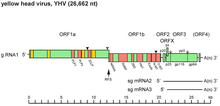Order is one of the eight major hierarchical taxonomic ranks in Linnaean taxonomy. It is classified between family and class. In biological classification, the order is a taxonomic rank used in the classification of organisms and recognized by the nomenclature codes. An immediately higher rank, superorder, is sometimes added directly above order, with suborder directly beneath order. An order can also be defined as a group of related families.

Coronaviruses are a group of related RNA viruses that cause diseases in mammals and birds. In humans and birds, they cause respiratory tract infections that can range from mild to lethal. Mild illnesses in humans include some cases of the common cold, while more lethal varieties can cause SARS, MERS and COVID-19, which is causing the ongoing pandemic. In cows and pigs they cause diarrhea, while in mice they cause hepatitis and encephalomyelitis.

Filoviridae is a family of single-stranded negative-sense RNA viruses in the order Mononegavirales. Two members of the family that are commonly known are Ebola virus and Marburg virus. Both viruses, and some of their lesser known relatives, cause severe disease in humans and nonhuman primates in the form of viral hemorrhagic fevers.
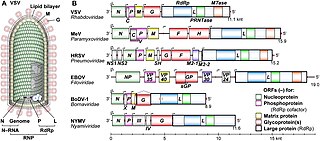
Mononegavirales is an order of negative-strand RNA viruses which have nonsegmented genomes. Some common members of the order are Ebola virus, human respiratory syncytial virus, measles virus, mumps virus, Nipah virus, and rabies virus. All of these viruses cause significant disease in humans. Many other important pathogens of nonhuman animals and plants are also in the group. The order includes eleven virus families: Artoviridae, Bornaviridae, Filoviridae, Lispiviridae, Mymonaviridae, Nyamiviridae, Paramyxoviridae, Pneumoviridae, Rhabdoviridae, Sunviridae, and Xinmoviridae.

The genus Marburgvirus is the taxonomic home of Marburg marburgvirus, whose members are the two known marburgviruses, Marburg virus (MARV) and Ravn virus (RAVV). Both viruses cause Marburg virus disease in humans and nonhuman primates, a form of viral hemorrhagic fever. Both are Select agents, World Health Organization Risk Group 4 Pathogens, National Institutes of Health/National Institute of Allergy and Infectious Diseases Category A Priority Pathogens, Centers for Disease Control and Prevention Category A Bioterrorism Agents, and are listed as Biological Agents for Export Control by the Australia Group.

Coronaviridae is a family of enveloped, positive-strand RNA viruses which infect amphibians, birds, and mammals. The group includes the subfamilies Letovirinae and Orthocoronavirinae; the members of the latter are known as coronaviruses.

Arteriviridae is a family of enveloped, positive-strand RNA viruses in the order Nidovirales which infect vertebrates. Host organisms include equids, pigs, Possums, nonhuman primates, and rodents. The family includes, for example, equine arteritis virus in horses which causes mild-to-severe respiratory disease and reproductive failure, porcine reproductive and respiratory syndrome virus type 1 and type 2 in pigs which causes a similar disease, simian hemorrhagic fever virus which causes a highly lethal fever, lactate dehydrogenase–elevating virus which affects mice, and wobbly possum disease virus.

Nidovirales is an order of enveloped, positive-strand RNA viruses which infect vertebrates and invertebrates. Host organisms include mammals, birds, reptiles, amphibians, fish, arthropods, molluscs, and helminths. The order includes the families Coronaviridae, Arteriviridae, Roniviridae, and Mesoniviridae.

The International Committee on Taxonomy of Viruses (ICTV) authorizes and organizes the taxonomic classification of and the nomenclatures for viruses. The ICTV has developed a universal taxonomic scheme for viruses, and thus has the means to appropriately describe, name, and classify every virus that affects living organisms. The members of the International Committee on Taxonomy of Viruses are considered expert virologists. The ICTV was formed from and is governed by the Virology Division of the International Union of Microbiological Societies. Detailed work, such as delimiting the boundaries of species within a family, typically is performed by study groups of experts in the families.

Torovirus is a genus of enveloped, positive-strand RNA viruses in the order Nidovirales and family Tobaniviridae. They primarily infect vertebrates, especially cattle, pigs, and horses. Diseases associated with this genus include gastroenteritis, which commonly presents in mammals. Torovirus is the only genus in the monotypic subfamily Torovirinae. Torovirus is also a monotypic taxon, containing only one subgenus, Renitovirus.
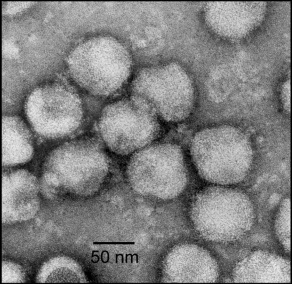
Mesoniviridae is a family of enveloped, positive-strand RNA viruses in the order Nidovirales which infect mosquitoes. The family is named after the size of the genomes relative to other nidoviruses, with meso- coming from the Greek word mesos, which means medium, and -ni being an abbreviation of nido.
Alphaabyssovirus is a genus of positive-strand RNA viruses in the order Nidovirales which infect sea hares. The genus is monotypic. It contains only the subgenus Aplyccavirus, which contains only one species, Aplysia abyssovirus 1. Alphaabyssovirus is also the only member of the subfamily Tiamatvirinae, which in turn is the only member of family Abyssoviridae, which likewise is the only member of the Abnidovirineae suborder. Aplysia abyssovirus 1 was first isolated from a sample from a California sea hare.
Alphamononivirus is a genus of enveloped, positive-strand RNA viruses in the order Nidovirales which infect planarian flatworms. Member virus planarian secretory cell nidovirus (PSCNV) has the largest known nonsegmented RNA genome of 41.1kb of any RNA virus. The genus is monotypic. It contains the subgenus Dumedivirus, which contains only one species, Planidovirus 1. Alphamononivirus is also the only member of the subfamily Mononivirinae, which in turn is the only member of family Mononiviridae, which likewise is the only member of the Monidovirineae suborder.
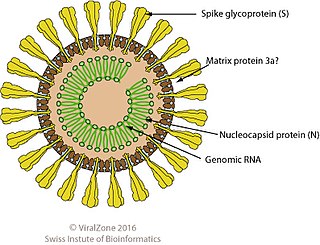
Mesnidovirineae is a suborder of enveloped, positive-strand RNA viruses in the order Nidovirales which infect invertebrates. Host organisms include mosquitoes.

Tobaniviridae is a family of enveloped, positive-strand RNA viruses in the order Nidovirales which infect vertebrates. Host organisms include mammals, fish, and snakes. The genome size of tobaniviruses ranges from 20 to 32 kilobases. The family is the only member of the suborder Tornidovirineae.
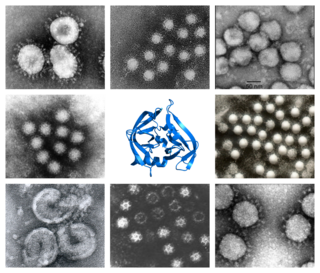
Pisoniviricetes is a class of positive-strand RNA viruses which infect eukaryotes. A characteristic of the group is a conserved 3C-like protease from the PA clan of proteases for processing the translated polyprotein. The name of the group is a portmanteau of member orders "picornavirales, sobelivirales, nidovirales" and -viricetes which is the suffix for a virus class.

Piscanivirinae is a virus subfamily of the family Tobaniviridae within the order Nidovirales which comprises different fish viruses. The virions have a viral envelope and a positive-sense single-stranded RNA genome which is linear and unsegmented.

Arnidovirineae is a suborder of viruses in the order Nidovirales. There are 4 families and 16 genera in the Arnidovirineae suborder.

Nanidovirineae is a suborder of viruses in the order Nidovirales, comprising two families.

